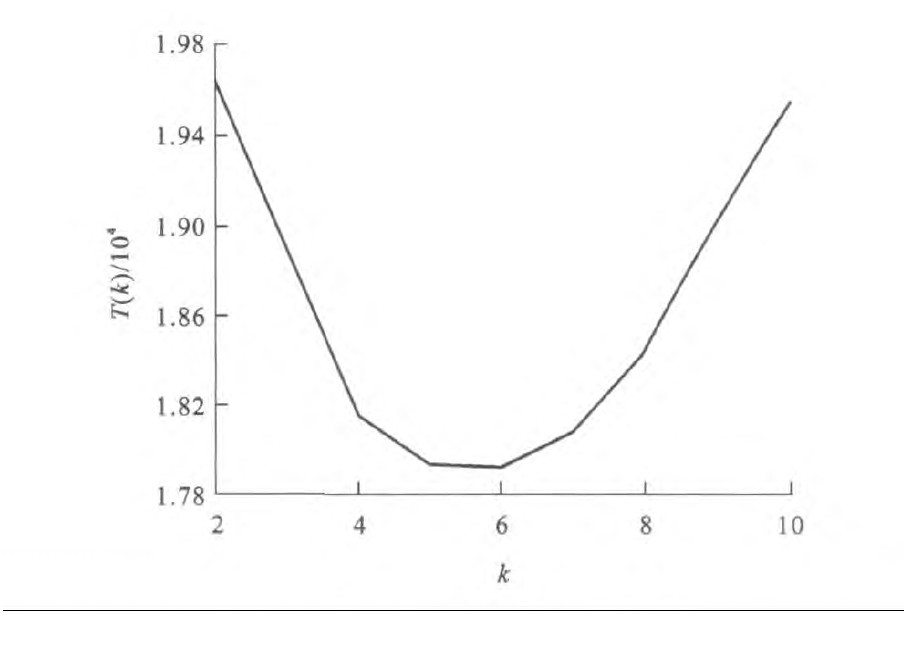Mixed clustering algorithm of airport capacity in stochastic GHP model
Article Text (Baidu Translation)
-
摘要: 为了有效利用机场容量资源, 克服现有随机GHP模型中容量预测存在的人为误差, 研究了机场容量混合聚类算法。将每天的容量按照30 min间隔划分为多个区间, 每个区间对应着1个容量值, 这样每天的容量就作为1个容量样本。采集国内某机场半年的容量样本, 采用k-means和SOM神经网络的混合聚类算法, 确定机场典型容量样本, 计算相应的概率, 建立典型容量样本树, 并应用于随机GHP的静态和动态模型。仿真结果表明: 与不执行GHP相比, 静态和动态模型的总延误损失分别减少了32.7%和52.7%, 验证了混合聚类算法的可行性以及典型容量样本树的实用性。Abstract: In order to make full use of airport capacity resources and eliminate existing human prediction error in stochastic ground holding policy(GHP) model, a mixed clustering algorithm was researched. Daily capacity was divided into several intervals in accordance with 30 min, each interval corresponded to a certain capacity value, and the capacity of one day was a capacity scenario. The capacity scenarios of an airport in half a year were collected, typical capacity scenarios were produced by using self-organizing-maps(SOM) neural network and k-means clustering algorithm, and the probability of each capacity scenario was calculated. Typical capacity scenario tree was constructed and applied in stochastic static and dynamic GHP models. Simulation result shows that compared with no-GHP case, the total delay costs of static and dynamic GHP models reduce by 32.7% and 52.7% respectively. So the mixed algorithm is feasible, and the typical capacity scenario tree is practical.
-
表 1 计算结果对比
Table 1. Comparison of computing results

-
[1] 王飞, 徐肖豪, 张静. 基于人工鱼群算法的单机场地面等待优化策略[J]. 南京航空航天大学学报, 2009, 41(1): 116-120. doi: 10.3969/j.issn.1005-2615.2009.01.023WANG Fei, XU Xiao-hao, ZHANG Jing. Single airport groundholding problem optimizing strategy based on artificial fish school algorithm[J]. Journal of Nanjing University of Aeronautics and Astronautics, 2009, 41(1): 116-120. (in Chinese) doi: 10.3969/j.issn.1005-2615.2009.01.023 [2] 周沁, 张军, 张学军. 机场流量管理模型的公平性与有效性研究[J]. 中国科技信息, 2005(4): 126, 116. https://www.cnki.com.cn/Article/CJFDTOTAL-XXJK200504114.htmZHOU Qin, ZHANG Jun, ZHANG Xue-jun. Equity and effectiveness study of airport flow management model[J]. China Science and Technology Information, 2005(4): 126, 116. (in Chinese) https://www.cnki.com.cn/Article/CJFDTOTAL-XXJK200504114.htm [3] PANAYIOTOU C G, CASSANDRAS C G. A sample path approach for solving the ground-holding policy problemin air traffic control[J]. IEEE Transactions on Control Systems Technology, 2001, 9(3): 510-523. doi: 10.1109/87.918903 [4] PULUGURTHA S S, NAMBISANS S. Using genetic algorithms to evaluate aircraft ground holding policy under static conditions[J]. Journal of Transportation Engineering, 2001, 127(5): 433-441. [5] 胡明华, 李丹阳, 李顺才. 空中交通地面等待问题的网络流规划模型[J]. 东南大学学报: 自然科学版, 2000, 30(3): 104-108. doi: 10.3321/j.issn:1001-0505.2000.03.023HU Ming-hua, LI Dan-yang, LI Shun-cai. Network programming algorithms for ground-holding strategy problem[J]. Journal of Southeast University: Natural Science Edition, 2000, 30(3): 104-108. (in Chinese) doi: 10.3321/j.issn:1001-0505.2000.03.023 [6] 李雄, 徐肖豪. 空中交通地面等待的指派问题模型[J]. 中国民航学院学报, 2004, 22(增): 87-90. https://www.cnki.com.cn/Article/CJFDTOTAL-ZGMH2004S1028.htmLI Xiong, XU Xiao-hao. Allocation problem model in air traffic ground holding[J]. Journal of Civil Aviation University of China, 2004, 22(S): 87-90. (in Chinese) https://www.cnki.com.cn/Article/CJFDTOTAL-ZGMH2004S1028.htm [7] 樊军, 王莉莉. 基于Hopfield网络的单机场地面等待优化算法[J]. 中国民航学院学报, 2004, 22(3): 11-13. doi: 10.3969/j.issn.1001-5590.2004.03.003FAN Jun, WANG Li-li. Optimal algorithm for single airport ground-holding problem basing on Hopfield neural network[J]. Journal of Civil Aviation University of China, 2004, 22(3): 11-13. (in Chinese) doi: 10.3969/j.issn.1001-5590.2004.03.003 [8] BALL M O, HOFFMAN R, ODONI A R, et al. A stochastic integer program with dual networkstructure andits application to the ground-holding problem[J]. Operation Research, 2003, 51(1): 167-171. doi: 10.1287/opre.51.1.167.12795 [9] KOTNYEK B, RICHETTA O. Equitable models for the stochastic ground-holding problem under collaborative decision making[J]. Transportation Science, 2006, 40(2): 133-146. doi: 10.1287/trsc.1050.0129 [10] MUKHERJEE A, HANSEN M. Adynamic stochastic model for the single airport ground holding problem[J]. Transportation Science, 2007, 41(4): 444-456. [11] INNISS T R, BALL M O. Estimating one-parameter airport arrival capacity distributions for air traffic flow management[J]. Air Traffic Control Quarterly, 2002, 12(4): 223-252. [12] LIU P C B, HANSEN M, MUKHERJEE A. Scenario-based management of air traffic flow: developing and using capacity scenario trees[J]. Transportation Research Record, 2006(1951): 113-121. [13] 袁方, 孟增辉, 于戈. 对k-means聚类算法的改进[J]. 计算机工程与应用, 2004(36): 177-178, 232. https://www.cnki.com.cn/Article/CJFDTOTAL-JSGG200436054.htmYUAN Fang, MENG Zeng-hui, YU Ge. Improvedk-means clustering algorithm[J]. Computer Engineering and Applications, 2004(36): 177-178, 232. (in Chinese) https://www.cnki.com.cn/Article/CJFDTOTAL-JSGG200436054.htm [14] ALAHAKOON D, HALGAMUGE S K. Dynamic self-organizing maps with controlled growth for knowledge discovery[J]. IEEE Transactions on Neural Networks, 2000, 11(3): 601-614. [15] 黄丽娟. 动态聚类新方法及最优聚类算法研究[D]. 扬州: 扬州大学, 2006.HUANG Li-juan. New non-hierarchical clustering objetives and the algorithms to optimal clustering[D]. Yangzhou: Yangzhou University, 2006. (in Chinese) -





 下载:
下载:





